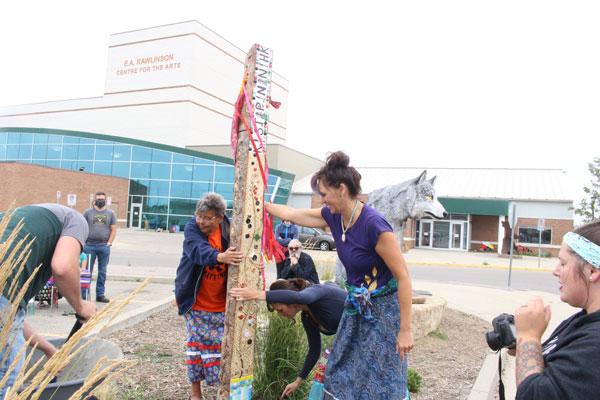
The Mann Art Gallery was one of 75 arts organizations, artists, and training programs recognized at the MacKenzie Art Gallery in Regina on Friday as part of the SK Arts reception.
The event was the culmination of a months-long campaign called We Celebrate You which was held to identify and reward those who are creating an exciting future for arts in the province.
Mann Art Gallery educator Lana Wilson said the gallery was nominated for the recognition by local artist Leah Dorion. Wilson said that it was exciting and unexpected to be nominated.
“It’s a very significant that Leah Dorian was the person who nominated us for this award,” Wilson said. “It was totally unexpected. She did not tell. I did not know that this award existed.”
The 75 nominees also receive a $750 grant towards their art practice. So far, three of the release features include Prince Albert artists.
The campaign continues with twice-weekly features on the agency website and social media channels and will run until November 2023.
SK Arts also recognized Prince Albert artists Dorion, Michelle Boutin, Danielle Castle, Donny Parenteau and Hannah Spriggs.
Prior to the nomination, Dorion spoke with Wilson about how the Mann works on engaging with artists. Wilson said they are committed to offering a wide range of options to the public from a wide-range of artists.
Wilson said they try to bring art to the public in unexpected ways, like the outdoor temporary art popping up around the City. She said they’ve also worked hard to partner with Indigenous artists to help them create their own workshops and programming.
These efforts are part of a larger goal to demystify the art gallery.
“Art galleries are often seen as elitist, and can be classist spaces,” Wilson said. “We’re really trying to break that down and I intend that our community programing and our arts education programing could help to do that, but I’m always looking for more feedback. It’s really nice to have Leah’s support. It indicates that she feels like, on some level, we’re succeeding in working towards that goal.”
Wilson said the education program at the gallery meets parts of the vision and mission statements for the organization. Gallery’s vison is to be a catalyst that bridges culture and community through the visual arts.
They do this through providing learning opportunities and art making, which are parts of the community programming.
“In terms of our mission statement, we exist to engage, facilitate and stimulate the development, presentation and preservation of visual arts for the diverse community of North Central Saskatchewan,” Wilson said. “So definitely, the art education program is designed, as is the collection or the curatorial program, to engage, facilitate and stimulate, especially the development and presentation of art.”
Wilson explained that arts education also benefits the community and the individual.
“For individual people, we do understand the world around us, we do understand our culture, the ways that we can communicate, especially with the visual arts,” she said.
Wilson said the arts education program has a key word: engagement.
“We can help talk about these things. We can learn from each other,” she explained. “We can learn by engaging in art, making together, in whatever form that looks like, and those things are important.
“On a personal level, it’s important for us to express our creativity and we can do that through hands-on art making, but we can learn more ways to express our creativity by talking about how other people do that, how other artists, on both the amateur and professional levels, do that.”
She added that arts education also has mental health benefits and allows people to inspire each other.
They also try to reach the broadest demographic possible. Wilson gave an example of how on Wednesday she will be doing arts education at a long-term care home so they also engage outside the gallery proper.
They also encourage schools and community groups to visit the gallery for field trips and tours. The gallery has a hands-on education program that is part of that tour.
They also deliver education programming directly to schools and community groups.
Wilson said arts education isn’t funded as well as it used to be in schools, and that makes it even more important for the gallery to get involved.
With opportunities shrinking in schools, they want to help to fill the gap.
michael.oleksyn@paherald.sk.ca
